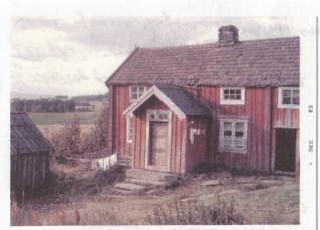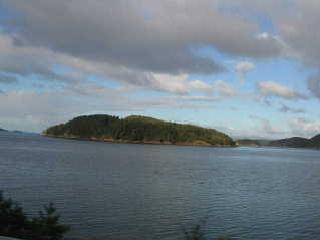SALTØY
SVEBUKTA (Skogset?)
SVEBERG (Skogset?)
Main Pages
LOCATIONS
SVEE FARMS IN NORWAYFarm names associated with this family have been listed as Saltøy, Svebukta and Sveberg(h).
SALTØY
The oldest known Svee farm in Norway was on Saltøy (an island) on the north end of Fættenfjord, an arm of Åsenfjord, until the family moved to the mainland. On a map of the Trøndheim area or a map that includes Skatval, this island is usually shown.
Ancestors in the direct line with John Svee who lived on Saltøy included:
*Arnt Jonson Saltøy 1710-1773 (John Svee's great-great grandfather).
Arnt bought farm in 1750 and it was in the family until 1900.
*Jon Arrntson Saltøy 1751-1836 (John Svee's great grandfather)
Jon bought the farm from Arnt in 1779.
*Andreas Jonson Saltøy 1782-1851 (John Svee's grandfather)
Andreas' brother, Arnt Jonson, bought the farm from his father in 1823.
Arnt Jonson's daughter Malena and her husband. Ola Jonson Skjervauran, bought the farm from Arnt in 1854.
Malena and Ola's son, Jon Olson Saltøy bought the farm from them in 1891.
Jon sold the farm in 1911 and it was no longer in the family.
In the 1801 census there were 10 people living in the house at Saltøy.
During the years when tuberculosis was a significant problem in Norway, the island was purchased by a union of doctors who used the island as a place for poor people to recuperate from tuberculosis. The people would spend 3-4 weeks there, hopefully having rest and some sunshine, and then return home. A relative mentioned in September, 2005, that Norway is now experiencing a resurgence of tuberculosis because of people from Russia/Eastern Europe coming to Norway.
In 2008, Saltøy is owned by a "Fellesforbundet" (RAF), a trade union in Trøndheim, and is used as a resort/vacation place for its members. A cartaker and his wife live on the island. The island had belonged to RAF since September 1949. After that it was bought by the public health district and used as a holiday place for children.
SVEBUKTA
Ancestors in the direct line with John Svee who lived there included:
*Andreas Jonson Saltøy 1782-1851 (John Svee's grandfather)
*Jonas Andreason Svebukta (John Svee's father)
1821-1899
*John J. Svee (1855-1931) and his brothers and sisters including *Arnt and *Gunnerius
The word "bukt" in Norwegian can mean a "bay" or "cove". There is a farm referred to as Svebukta near the fjord, looking out to Saltøy and two local people, Olav Vinge of Skatval and Ingrid Brechen of Lade thought that John Svee would have lived on a hussman plass which would have been part of Svebukta .
Even though there are references to Jonas Andreason and John J. Svee at Svebukta, did they actually live at the place I am referring to as Sveberg?
There are maps that show a farm in the about the same location as Svebukta named "Svea". Are these just 2 names for the same farm or are they different farms?
SVEBERG
In Norwegian the word "berg" can mean a hill or mountain. The hussman plass where John Svee lived was on a large hill near Svebukta and looking out to Saltøy. Is this possibly Skogset?
In 2005, we visited the location said to be the hussman plass where John Svee lived. The owner of the property took us to a location near his house where the foundation of the hussman plass was located. Today it is grown over with grass. The building had been torn down when the E-6 was built and part of the property is now under the E-6 motorway. I believe that the hussman plass was part of the farm, Svebukta, which is much closer to the water. Near Svebukta there is a point where families walked out to see if the fishing boats of their men were returning from the sea.
From the hussman plass and Svebukta, you could look out to Saltøy. You can also look out to Saltøy from Forbordfjellet, Steinvikholm, and the E-6 motorway as you drive past the end of the arm of the fjord.
The owner said if I was related to Julie and Magnar Karlsen, then I was probably related to his 2 year-old daughter we saw playing on a swing set in the yard. My cousins, Janice Ray and her sister Marilyn, visited Svee farms with Julie and Magnar Karlsen in the 1970's. VERIFY DATE AND SPELLING.
 |
|
| Åsenfjord (in the distance) Fættenfjord (in the forground). The larger island is Saltøy A fantastic shot from the Wikipedia website In the picture above, on the mainland to the left is
Sveberg, Svebukta, Sve gård, Røkke, Fiskvik, Vinje - all
farms/locations associated with the Svee/Rokke/Vinge parts of my family
in Norway.
The bottom right of this picture is where the Germans hid the battleship Tirpitz from the allies in WWII. <Click to learn more about the Tirpitz in Fættenfjord further down this page> |
Sve Gård Farm 47 Steinvikholmen in the background Mary Iwen Lamp has this postcard in her collection of photos from her mother, Thena Svee Iwen (daughter of John Svee).
Sve Gård is on the mainland across from Saltøy and appears to be the main farm at Sve(47). There were several other place names at Sve including *Krokvika (47,3) *Berg (47,5) (note same place number as Skogset). This may also be the place referred to as "Sveberg". *Skogset (47,5) *Svebukta (47,6) (another reference to 47,6 also mentions Skogset) *Vegum (47,7) with Austre Svesjøen, Vestre Svesjø, Austre Svebakken, Svehaugen, and Svegjerdet. |
| After
living on Saltøy, records in bygdeboks list Svee family members as
living at Svebukta and using Svebukta as a family name. Some more research is needed as to where they actually lived at Sve. Svebukta(47,6) AND Skogset have been mentioned in the same reference. Skogset(47,5) AND Berg have been mentioned in the same reference. |
 Picture 47,5 - Skogset |
 |
 |
| Old picture - possibly "Sveberg" (1970 photo) Thought by some family members to be at the location of the hussman plass where John Svee was said to have lived.
This picture is perhaps from when other relatives visited Trønderlag in the 1970's. If correct, in the distance to the right would be SALTØY. A note on the back of the picture states "Svee home in Skatval". Is this the same building as the red one below, but after renovation? Was this the building that was ultimately torn down when the E-6 was built? I need more details? |
New home - possibly "Sveberg" (2005 photo) I believe that an old bygdbok shows this place listed under the name "Skogset". Could Sveberg, and Skogset, be the same place? Another bygdebok lists Svebukta 47,6 and Skogset being the same place. Another book lists 47,5 as simply "Berg" but part of Sve 47.
When we took this picture above in 2005, the owner said that an old foundation just barely visible in the ground behind this house is possibly the location of the old Sveberg house (see picture below where I am standing on the old foundation). This home is on the mainland across from Saltøy |
 Birthplace of John J. Svee? (1963 photo)
Written on the back of this photo is the following:
**************************************"Skatvold Parish, Lower Stordalen Norway.
**************************************Our father, John J. Svee was born in this house, Oct. 9, 1854. He came to America at the age of 21 yrs. in the year 1875. Married Beret Rokke in 1885. His parents were Johannes Svee and Elizabeth Arnestad. This picture was taken by Odd Rovick when he and his wife visited Norway. No Svee there now". Is this the same building as
the yellow one above this photo before it was renovated, only to be
torn down when the E-6 was built, or is it a completely different
building? I must do some research on this. The
references to the names of John's parents indicates that the writer had
incomplete knowledge about his/her parents. I need to verify who
wrote on the back of the photo. I also need the original photo for better scan.
|
 Hussman Plass of John J. Svee? As seen from the location of the hussman plass where John Svee was said
to have lived. I am standing on the location of the foundation of
the house and behind the house in the photograph above. Behind me
is a fence and below that is a steep drop to the E-6 motorway. In the
distance, across the water behind me, is Saltøy.
|
The picture shows about 1/2 of Saltøy. |
|
 Saltøy - 2008 Picture
(as seen from the E-6 motorway)
|
 Location of the Tirpitz in relationship to Saltøy. Notice the flak guns on Saltøy and the small skerries next to it. |
| Learn more below about German battleships near the island during WWII. | |
 Tirpitz photo credits www.museumnett.no www.bismarck-class.dk |
 |
| Battleship Tirpitz, the sister ship of the Bismarck, in Fættenfjord in June, 1942 | On November 12, 1944 the
Tirpitz was attacked and finally sank immediately to the west of
Tromsø, in the bay of Håkøybotn. |
THE BATTLESHIP TIRPITZ
In 1942, the battleship "Tirpitz", moored in Fættenfjord, was attacked by allied forces. The Tirpitz, the largest war ship built in Germany, was a sister-ship of the Bismarck and was seen as one of the most modern battleships in World War Two. When commissioned, It was the largest battle ship in the world until the Japanese "Yamato" was commissioned in December 1941.
14 January 1942 Tirpitz, escorted by the destroyers Richard Beitzen, Paul Jacobi, Bruno Heinemann and Z29, transferred from Wilhelmshaven, Germany to Trondheim, Norway. It was 4 days later than originally planned. Tirpitz arrived, together with the destroyers, at Trondheim in Norway and anchored in Fættenfjord 16 January 1942. Fættenfjord is the small arm of Åsenfjord just beyond the island of Saltøy, the Svee family ancestral home. Also, you look out onto Fættenfjord from Svebukta and Sveberg, both places of the Svee family.
On the map of Tirpitz locations above you can see the location of a German flak gun emplacement on Saltøy, and the surrounding area.
Saltoy was the landmark that the Halifax aircraft used as a reference point to line up bombing runs on Tirpitz in Fættenfjord
The Tirpitz was later sunk off Håkøy near Tromsø, Norway, in 1944.
Read more about the Tirpitz at: http://www.bismarck-class.dk/
Click on the following links for some great pictures of the Tirpitz in Fættenfjord. Notice Saltøy in some of the shots.
http://www.bismarck-class.dk/tirpitz/miscellaneous/tirpitz_faettenfjord_then_and_now/tirpitz_faettenfjord_then_and_now.html
http://www.bismarck-class.dk/tirpitz/gallery/themes/gallthemetirfaettenfjord.html